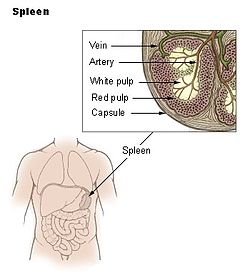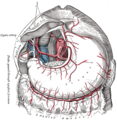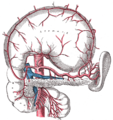Spleen
| Spleen | |
|---|---|
 Spleen | |
 Laparoscopic view of a horse's spleen. (The purple and grey mottled organ). | |
| Details | |
| Precursor | Mesenchyme of dorsal mesogastrium |
| Artery | Splenic artery |
| Vein | Splenic vein |
| Nerve | Splenic plexus |
| Identifiers | |
| Latin | splen, lien |
| MeSH | D013154 |
| TA98 | A13.2.01.001 |
| TA2 | 5159 |
| FMA | 7196 |
| Anatomical terminology | |
The spleen is an organ of the abdomen, where it functions in the destruction of old red blood cells and holding a reservoir of blood. It is regarded as one of the centers of activity of the reticuloendothelial system (part of the immune system). Until recently, the purpose of the spleen was not known. It is increasingly recognized that its absence leads to a predisposition to certain infections.
Anatomy
The human spleen is located in the upper left part of the abdomen, behind the stomach and just below the diaphragm. In normal individuals this organ measures about 125 × 75 × 50 mm (5 × 3 × 2 inches) in size, with an average weight of 150 g.
The spleen is the largest organ derived from mesenchyme and lying in the mesentery. It consists of masses of lymphoid tissue of granular appearance located around fine terminal branches of veins and arteries. These vessels are connected by modified capillaries called splenic sinuses.
Approximately 10% of people have one or more accessory spleens. They may form near the hilum of the main spleen, the junction at which the splenic vessels enter and leave the organ.
There are several peritoneal ligaments that support the spleen[1] (to understand their naming it helps to know that "lien" is an alternate root for "spleen")
- gastrolienal ligament (gastrosplenic) - connects stomach to spleen.
- lienorenal ligament (splenorenal) - connects spleen to kidney.
- phrenicocolic ligament - connects left colic flexure to the thoracic diaphragm. The middle connects to the spleen.
Cross sections of the spleen reveal a red soft surface which is divided into two types of pulp which correspond to the two most important functional roles of the spleen, summarized below:[2]
| Area | Composition | Function |
| red pulp | Composed smally of: * "sinuses" (or "sinusoids") which are filled with blood * "splenic cords" of reticular fibers * "marginal zone" bordering on white pulp |
Mechanical filtration. Removes unwanted materials from the blood, including senescent red blood cells. |
| white pulp | Composed of nodules, called Malpighian corpuscles. These are composed of: * "lymphoid follicles" (or "follicles"), rich in B-lymphocytes * "periarteriolar lymphoid sheaths" (PALS), rich in T-lymphocytes |
Helps fight infections. |
Other functions of the spleen are less prominent, especially in the healthy adult:
- Creation of red blood cells. While the bone marrow is the primary site of hematopoeisis in the adult, up until the fifth month of gestation, the spleen has important hematopoietic functions. After birth, no significant hematopoietic function is left in the spleen except in some hematologic disorders: e.g. myelodysplastic syndrome, hemoglobinopathies.
- Storage of red blood cells and other formed elements. This is only valid for certain mammals, such as dogs and horses. In horses roughly 50% of the red blood cells are stored there. The red blood cells can be released when needed. In humans, however, the spleen does not function as a deposit of red blood cells, but instead it stores platelets in case of an emergency .[3] These animals also have large hearts in relation to their body size to accommodate the higher-viscosity blood that results. Some athletes have tried doping themselves with their own stored red blood cells to try to achieve the same effect, but the human heart is not equipped to handle the higher-viscosity blood.
Disorders
Enlargement of the spleen is known as splenomegaly. It may be caused by sarcoidosis, malaria, bacterial endocarditis, leukaemia, pernicious anaemia, leishmaniasis, Hodgkin's disease, Banti's disease, hereditary spherocytosis, cysts, glandular fever (mononucleosis or 'Mono' caused by the Epstein-Barr Virus), and tumours. Primary tumours of the spleen include hemangiomas and hemangiosarcomas. Marked splenomegaly may result in the spleen occupying a large portion of the left side of the abdomen.
The spleen is the largest collection of lymphoid tissue in the body. It is normally palpable in preterm infants, in 30% of normal, full-term neonates, and in 5% to 10% of infants and toddlers. A spleen easily palpable below the costal margin in any child over the age of 3-4 years should be considered abnormal until proven otherwise.
Splenomegaly can result from antigenic stimulation (eg, infection), obstruction of blood flow (eg, portal vein obstruction), underlying functional abnormality (eg, hemolytic anemia), or infiltration (eg, leukemia or storage disease, such as Gaucher's disease). The most common cause of acute splenomegaly in children is viral infection, which is transient and usually moderate. Basic work-up for acute splenomegaly includes a complete blood count with differential, platelet count, and reticulocyte and atypical lymphocyte counts to exclude hemolytic anemia and leukemia. Assessment of IgM antibodies to viral capsid antigen (a rising titer) is indicated to confirm Epstein-Barr virus or cytomegalovirus. Other infections should be excluded if these tests are negative.
Absence
The absence of a spleen predisposes to some septicaemia infections. Vaccination and antibiotic measures are discussed under asplenia.
- Some people congenitally completely lack a spleen, although this is rare.
- Sickle-cell disease can cause a functional asplenia (or autosplenectomy) by causing infarctions of the spleen during repeated sickle-cell crises.
- It may be removed surgically (known as a splenectomy), and indeed often is. For example, it may be removed following abdominal injuries with rupture and hemorrhage of the spleen, or in the treatment of certain blood diseases (Idiopathic thrombocytopenic purpura, hereditary spherocytosis, etc.), certain forms of lymphoma or for the removal of splenic tumours or cysts.
Etymology and cultural views
The word spleen comes from the Greek splēn.
In French, spleen refers to a state of pensive sadness or melancholy. It has been popularized by the poet Charles-Pierre Baudelaire (1821-1867) but was already used before, in particular in the Romantic literature (18th century). The connection between spleen (the organ) and melancholy (the temperament) comes from the humoral medicine of the ancient Greeks. One of the humours (body fluid) was the black bile, secreted by the spleen organ and associated with melancholy. In contrast, the Talmud (tractate Berachoth 61b) refers to the spleen as the organ of laughter, possibly suggesting a link with the humoral view of the organ.
In German, the word "spleen", pronounced as in English, refers to a persisting somewhat cranky (but not quite lunatic) idea or habit of a person; however the organ is called "Milz", (cognate with Old English milte). In 19th century England women in bad humour were said to be afflicted by spleen, or the vapours of spleen. In modern English "to vent one's spleen" means to vent one's anger, e.g. by shouting, and can be applied to both males and females.
In China, the spleen '脾 (pí)' counts as the seat of one's temperament and is thought to influence the individual's willpower. Analogous to "venting one's spleen", "发脾气" is used as an expression for getting angry, although in the view of Traditional Chinese Medicine, the view of "脾" does not correspond to the anatomical "spleen".
See also
Additional images
-
The celiac artery and its branches.
-
The celiac artery and its branches.
-
Horizontal disposition of the peritoneum in the upper part of the abdomen.
-
Transverse section through the middle of the first lumbar vertebra.
-
The duodenum and pancreas.
-
The visceral surface of the spleen.
-
Transverse section of the spleen, showing the trabecular tissue and the splenic vein and its tributaries.
-
Transverse section of the human spleen, showing the distribution of the splenic artery and its branches.
-
Section of the spleen, showing the termination of the small bloodvessels.
-
Back of lumbar region, showing surface markings for kidneys, ureters, and spleen.
-
Side of thorax, showing surface markings for bones, lungs (purple), pleura (blue), and spleen (green).
-
Lymphatic system
Footnotes
- ^ spleen at The Anatomy Lesson by Wesley Norman (Georgetown University)
- ^ Histology image: 07701loa – Histology Learning System at Boston University
- ^ Carey, Bjorn (May 5, 2006). "Horse science: What makes a Derby winner - Spleen acts as 'natural blood doper,' scientist says". MSNBC.com. Microsoft. Retrieved 2006-05-09.
External links
- Anatomy figure: 38:03-01 at Human Anatomy Online, SUNY Downstate Medical Center - "The visceral surface of the spleen."
- Anatomy image:7881 at the SUNY Downstate Medical Center












